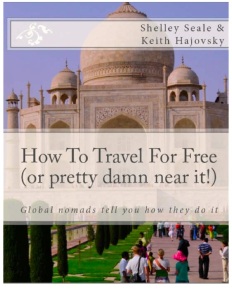Forget Budget Travel – Learn to Travel for Free!
 Are you tired of the conventional wisdom that says that you have to spend a lot of money to travel the world? Well, it’s not true. In spite of the general consensus that you have to be rich to travel extensively, I will let you in on a little secret: not only is it possible to travel very cheaply, it’s also possible to travel completely for free.
Are you tired of the conventional wisdom that says that you have to spend a lot of money to travel the world? Well, it’s not true. In spite of the general consensus that you have to be rich to travel extensively, I will let you in on a little secret: not only is it possible to travel very cheaply, it’s also possible to travel completely for free.
I’m not talking about becoming a tour guide or working on a cruise ship, although these are certainly possibilities if you are interested in doing so. I am talking about methods, resources and tricks that enable average people – with houses, bills, families and obligations – to travel for free, whether that is for a week in a neighboring state or a year in some far-flung corner of the world.
 The secret lies in completely discarding conventional “wisdom” about travel, and opening yourself up to creative possibilities. This is something that my partner, Keith, and I have done for years – both separately before we ever met, and over the past couple of years as we’ve traveled together. From spending two weeks in Hawaii completely free, to a month last year in a Barcelona apartment and this year in a Manhattan apartment – to Keith’s vagabonding around Asia for two years earlier this decade – we have managed to visit some of the world’s most exotic destinations for less than what many people would spend on a weekend trip.
The secret lies in completely discarding conventional “wisdom” about travel, and opening yourself up to creative possibilities. This is something that my partner, Keith, and I have done for years – both separately before we ever met, and over the past couple of years as we’ve traveled together. From spending two weeks in Hawaii completely free, to a month last year in a Barcelona apartment and this year in a Manhattan apartment – to Keith’s vagabonding around Asia for two years earlier this decade – we have managed to visit some of the world’s most exotic destinations for less than what many people would spend on a weekend trip.
People ask both of us, all the time, how do we do it? They are admiring, envious, impressed and mystified. They sigh and say, “I wish I could afford to go to Europe or Asia for two months.” But the truth is, most of the people who say this have far more financial means than we do. They could do exactly what we do, if only they knew how. And so can you.
First, let’s talk about some of the general “mindset” rules that will help you shift gears into traveling for free, or very near it:
• Money is, by far, not the primary requisite for world travel.
• You will sacrifice either time or money to travel, and you have to decide which. The more time you’re willing to spend on planning and being resourceful, the less money you’ll part with.
• Flexibility is key; the more open you can be about where and when you travel, the more low-cost and free opportunities open up to you.
• The longer you travel, the less expensive it becomes.
• The slower you travel, the more meaningful it becomes.
This last one is particularly important to both of us, and is one of the biggest rewards that come with traveling slower, longer and more inexpensively. The more creative you get, the richer experiences you will have. The cheapest methods of travel are usually the ones that the locals use, and by traveling in this manner you will have more interaction with them in a true cultural exchange.
 Tourists leave home to escape their world, while true travelers leave home to find it. When you only have a very short time to “vacation,” by necessity you will spend the majority of time in the most touristy areas of a place. There are two major drawbacks to this: First, these are always the most expensive places to be, and in some countries, visitors can spend more money in one week than many locals will make in a year. Second, these tourist zones most often consist of a sort of “show” that is put on to attract visitors, rather than an authentic experience of what the people, place, history and culture are really all about. These two drawbacks define the proverbial “tourist trap.”
Tourists leave home to escape their world, while true travelers leave home to find it. When you only have a very short time to “vacation,” by necessity you will spend the majority of time in the most touristy areas of a place. There are two major drawbacks to this: First, these are always the most expensive places to be, and in some countries, visitors can spend more money in one week than many locals will make in a year. Second, these tourist zones most often consist of a sort of “show” that is put on to attract visitors, rather than an authentic experience of what the people, place, history and culture are really all about. These two drawbacks define the proverbial “tourist trap.”
Second, let’s look at some of the specific top methods that we personally utilize, to travel for free or very close to it. I should say here that although I am a travel writer (and of course frequently travel comes along with that), these methods are things that anyone can do. Most of my free and dirt-cheap travel has not relied upon my profession, but rather using resources available to anyone.
• Frequent Flyer Programs. They may be getting a bad rap lately, but there are still plenty of opportunities to reap their rewards if you know how to play the game. Pick the right program and take advantage of all the ways you can earn miles, from credit cards to things you use anyway such as banking and utilities, and you can earn free tickets faster than you think.
• Low Cost Airlines. All around the world, regional airlines exist that offer some of the most amazing deals. By knowing who they are, subscribing to their e-bulletins, and keeping up with their deals, you can often find flights where the only thing you have to pay for is the airport taxes.
• Trains, Buses and Ferries. Don’t overlook alternate ways to travel. In keeping with the “slow travel” philosophy, if you have the time to spend utilizing these transportation methods, you will save huge amounts of money. In many parts of the world, traveling by train or boat is much more accessible and done regularly.
• Ride Sharing, Biking and Walking. Don’t even assume that the only way to get somewhere is by vehicle. When driving by car, you can often save huge amounts of money, or even get a free ride, by sharing the journey. Biking and walking are usually free too, and the United States as well as many places around the world offer incredible journeys by foot or bicycle.
• Hostels, Homestays and Couch Surfing. Once you arrive at your destination, it’s not necessary to spend big bucks on a hotel. Staying in a local’s home is usually very cheap and sometimes even free, and hostels aren’t the dirty dorm rooms that they used to be. These types of accommodations have the added benefit of much more interaction with the people who live there.
• Home and Hospitality Exchanges. Often overlooked by most travelers, exchanging homes or guest hospitality is one of the easiest, and most interesting, ways to get completely free accommodations that I’ve every come across; I’ve done it more than a dozen times.
• Monasteries, Farmstays and other Creative Lodging. There is an almost endless choice of options out there for cheap or free accommodations, from staying in a monastery or convent for just a few bucks, to bartering your work or volunteer time in exchange for a place to stay and sometimes even meals as well.
Besides these specific methods that we discuss in detail in our book, How To Travel For Free (or damn close to it!), there are so many ways to get creative about traveling. From working your way around the world, taking a sabbatical from work or combining job training or educational studies with traveling, seeing the world doesn’t have to cost very much. In fact, it can often be done for far less money than the cost of staying home and paying all those monthly bills.
So, in the words of Mark Twain, “Throw off the bowlines, sail away from the safe harbor. Catch the trade winds in your sails. Explore. Dream. Discover.”
 About the Author:
About the Author:
Shelley Seale is the co-author, with Keith Hajovsky, of How To Travel For Free (or damn close to it!). In this 70-page book, available as a PDF download or in softcover print, Seale and Hajovsky outline all the details of the above methods and more; providing examples, personal accounts, and hundreds of websites and resources that you can use to travel for free, as they have.




















